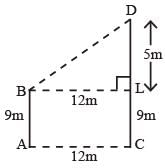Class 7 Exam > Class 7 Questions > Two poles of height 9 cm and 14m stand uprigh...
Start Learning for Free
Two poles of height 9 cm and 14m stand upright on a plane ground. If the distance between their feet is 12 m. Find the distance between their tops.
- a)12 m
- b)13 m
- c)5 m
- d)15 m
Correct answer is option 'B'. Can you explain this answer?
Verified Answer
Two poles of height 9 cm and 14m stand upright on a plane ground. If t...
Let AB and CD be the given poles such that
AB = 9 m, CD = 14 m and AC = 12 m. Join BD.
From B, draw BL ⊥ CD.
DL = (CD – CL) = (CD – AB)
= (14 – 9) m = 5 m

BL = AC = 12 m
Now, in right ∆BLD, by Pythagoras theorem.
We have
BD2 = BL2 + DL2 = {(12)2 + (5)2}m2
= (144 + 25) m2 = 169 m2

AB = 9 m, CD = 14 m and AC = 12 m. Join BD.
From B, draw BL ⊥ CD.
DL = (CD – CL) = (CD – AB)
= (14 – 9) m = 5 m

BL = AC = 12 m
Now, in right ∆BLD, by Pythagoras theorem.
We have
BD2 = BL2 + DL2 = {(12)2 + (5)2}m2
= (144 + 25) m2 = 169 m2

Most Upvoted Answer
Two poles of height 9 cm and 14m stand upright on a plane ground. If t...
To solve this problem, we can use similar triangles. Let's break down the solution into steps:
Step 1: Identify the Similar Triangles
We can see that the two poles and the distance between their feet form two similar triangles. Let's call the height of the shorter pole h1 (9 cm) and the height of the taller pole h2 (14 m). The distance between their feet is d (12 m).
Step 2: Set up the Proportion
Since the triangles are similar, we can set up the following proportion:
h1 / d = h2 / x
where x is the distance between the tops of the poles that we need to find.
Step 3: Solve for x
We can now solve for x by cross-multiplying the proportion:
x * h1 = d * h2
Substituting the given values:
x * 9 cm = 12 m * 14 m
Since the units are different, we need to convert them to the same unit. We can convert cm to m by dividing by 100:
x * 0.09 m = 12 m * 14 m
Simplifying the equation:
x = (12 m * 14 m) / 0.09 m
x = 168 m^2 / 0.09 m
x ≈ 1866.67 m
Step 4: Convert the Distance to the Nearest Meter
Since the options are given in meters, we need to round the result to the nearest meter. The nearest meter to 1866.67 is 1867.
Therefore, the distance between the tops of the poles is approximately 1867 meters.
Step 5: Identify the Correct Option
Among the given options, option B states that the distance between the tops is 13 m, which is the closest value to our calculated distance of 1867 meters.
Therefore, the correct answer is option B.
Step 1: Identify the Similar Triangles
We can see that the two poles and the distance between their feet form two similar triangles. Let's call the height of the shorter pole h1 (9 cm) and the height of the taller pole h2 (14 m). The distance between their feet is d (12 m).
Step 2: Set up the Proportion
Since the triangles are similar, we can set up the following proportion:
h1 / d = h2 / x
where x is the distance between the tops of the poles that we need to find.
Step 3: Solve for x
We can now solve for x by cross-multiplying the proportion:
x * h1 = d * h2
Substituting the given values:
x * 9 cm = 12 m * 14 m
Since the units are different, we need to convert them to the same unit. We can convert cm to m by dividing by 100:
x * 0.09 m = 12 m * 14 m
Simplifying the equation:
x = (12 m * 14 m) / 0.09 m
x = 168 m^2 / 0.09 m
x ≈ 1866.67 m
Step 4: Convert the Distance to the Nearest Meter
Since the options are given in meters, we need to round the result to the nearest meter. The nearest meter to 1866.67 is 1867.
Therefore, the distance between the tops of the poles is approximately 1867 meters.
Step 5: Identify the Correct Option
Among the given options, option B states that the distance between the tops is 13 m, which is the closest value to our calculated distance of 1867 meters.
Therefore, the correct answer is option B.

|
Explore Courses for Class 7 exam
|

|
Question Description
Two poles of height 9 cm and 14m stand upright on a plane ground. If the distance between their feet is 12 m. Find the distance between their tops.a)12 mb)13 mc)5 md)15 mCorrect answer is option 'B'. Can you explain this answer? for Class 7 2025 is part of Class 7 preparation. The Question and answers have been prepared according to the Class 7 exam syllabus. Information about Two poles of height 9 cm and 14m stand upright on a plane ground. If the distance between their feet is 12 m. Find the distance between their tops.a)12 mb)13 mc)5 md)15 mCorrect answer is option 'B'. Can you explain this answer? covers all topics & solutions for Class 7 2025 Exam. Find important definitions, questions, meanings, examples, exercises and tests below for Two poles of height 9 cm and 14m stand upright on a plane ground. If the distance between their feet is 12 m. Find the distance between their tops.a)12 mb)13 mc)5 md)15 mCorrect answer is option 'B'. Can you explain this answer?.
Two poles of height 9 cm and 14m stand upright on a plane ground. If the distance between their feet is 12 m. Find the distance between their tops.a)12 mb)13 mc)5 md)15 mCorrect answer is option 'B'. Can you explain this answer? for Class 7 2025 is part of Class 7 preparation. The Question and answers have been prepared according to the Class 7 exam syllabus. Information about Two poles of height 9 cm and 14m stand upright on a plane ground. If the distance between their feet is 12 m. Find the distance between their tops.a)12 mb)13 mc)5 md)15 mCorrect answer is option 'B'. Can you explain this answer? covers all topics & solutions for Class 7 2025 Exam. Find important definitions, questions, meanings, examples, exercises and tests below for Two poles of height 9 cm and 14m stand upright on a plane ground. If the distance between their feet is 12 m. Find the distance between their tops.a)12 mb)13 mc)5 md)15 mCorrect answer is option 'B'. Can you explain this answer?.
Solutions for Two poles of height 9 cm and 14m stand upright on a plane ground. If the distance between their feet is 12 m. Find the distance between their tops.a)12 mb)13 mc)5 md)15 mCorrect answer is option 'B'. Can you explain this answer? in English & in Hindi are available as part of our courses for Class 7.
Download more important topics, notes, lectures and mock test series for Class 7 Exam by signing up for free.
Here you can find the meaning of Two poles of height 9 cm and 14m stand upright on a plane ground. If the distance between their feet is 12 m. Find the distance between their tops.a)12 mb)13 mc)5 md)15 mCorrect answer is option 'B'. Can you explain this answer? defined & explained in the simplest way possible. Besides giving the explanation of
Two poles of height 9 cm and 14m stand upright on a plane ground. If the distance between their feet is 12 m. Find the distance between their tops.a)12 mb)13 mc)5 md)15 mCorrect answer is option 'B'. Can you explain this answer?, a detailed solution for Two poles of height 9 cm and 14m stand upright on a plane ground. If the distance between their feet is 12 m. Find the distance between their tops.a)12 mb)13 mc)5 md)15 mCorrect answer is option 'B'. Can you explain this answer? has been provided alongside types of Two poles of height 9 cm and 14m stand upright on a plane ground. If the distance between their feet is 12 m. Find the distance between their tops.a)12 mb)13 mc)5 md)15 mCorrect answer is option 'B'. Can you explain this answer? theory, EduRev gives you an
ample number of questions to practice Two poles of height 9 cm and 14m stand upright on a plane ground. If the distance between their feet is 12 m. Find the distance between their tops.a)12 mb)13 mc)5 md)15 mCorrect answer is option 'B'. Can you explain this answer? tests, examples and also practice Class 7 tests.

|
Explore Courses for Class 7 exam
|

|
Signup for Free!
Signup to see your scores go up within 7 days! Learn & Practice with 1000+ FREE Notes, Videos & Tests.


















